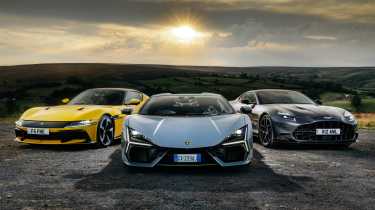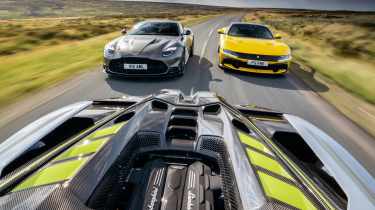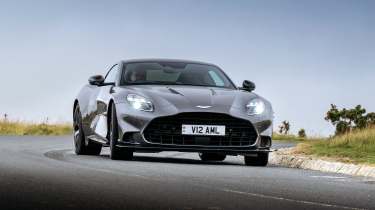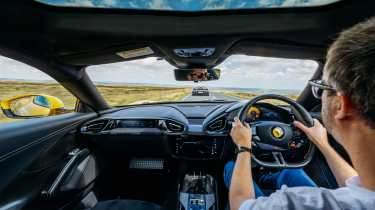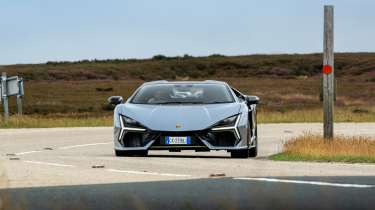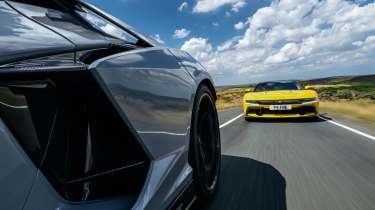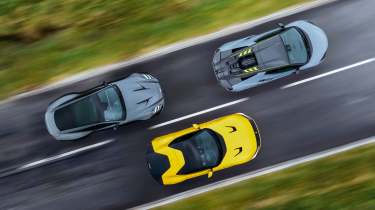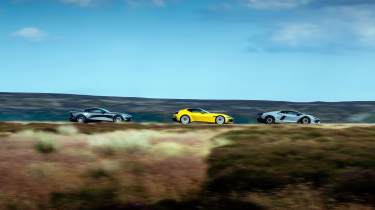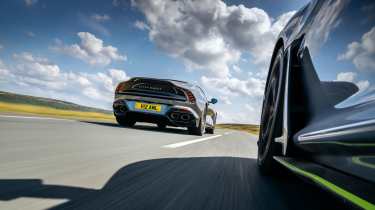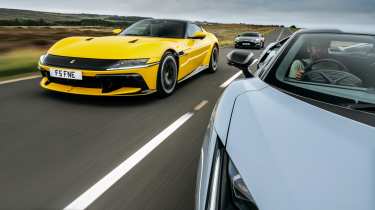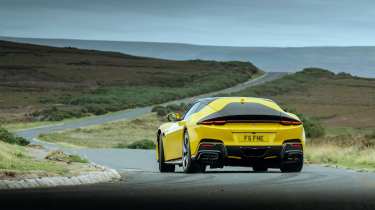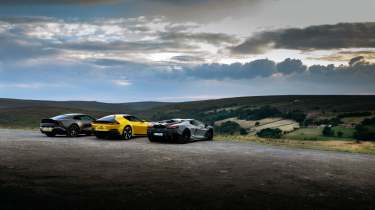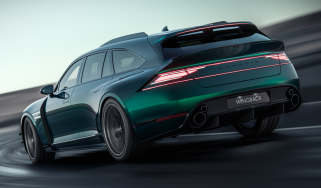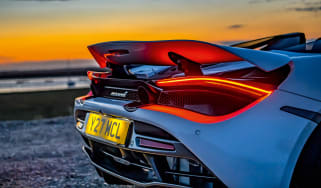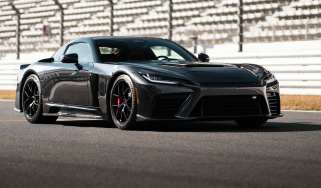Who makes the best V12 supercar? Ferrari, Lamborghini and Aston Martin go head-to-head
Three magnificent V12-engined supercars, hybrid-powered Lamborghini Revuelto, twin-turbocharged Aston Martin Vanquish and pure naturally aspirated Ferrari 12 Cilindri, gather to do battle. Which will triumph?
Banana Skids is easily assigned, but what about the others? Delving into Barker’s cornucopia of cheap confectionery, we pluck some more sugary sticks from the multicoloured bag and lay them out on the bonnet. The tutti-frutti flavour Stinger (self-proclaimed ‘cheekiest chew bar on the planet’) seems to fit with the Lamborghini livery’s lime highlights. The Vanquish is a little harder to tally with one of the remaining dentists’ friends, but we decide that a Drumstick fits the bill for the big Aston.
Such are the group test games that get played when you’re loitering in a lay-by on some Yorkshire moorland, waiting for the right intensity of light for the next photo. Twelve years ago it was probably pizza toppings that we allocated to these three cars’ V12 predecessors over in Italy (issue 182). Back then it was an F12 Berlinetta, an Aventador LP700‑4 and a second-generation Vanquish that we’d gathered together in Emilia-Romagna. And it is actually very heartening to find that over a decade later we can still bring together a trio of big-hitting V12s. I’m sure in 2013 we were all fearful of an emissions chequered flag falling on new cars with twelve cylinders and each pot nearly the size of a pint. But here we are. The question is, has there been progress or are they merely clinging on? Are they dozen-cylinder Jacks treading water ever more frantically while a regulatory Rose says there’s no more room on her bit of driftwood?
Well, in terms of power, things are looking better than ever. Back then the total was a healthy 1985bhp, split 690, 730 and 565 between Lambo, Ferrari and Aston respectively. Now it’s a positively monstrous 2644bhp divvied up 1001, 819, 824. Torque has taken slightly less of an uptick with 509, 509 and 457lb ft converting to 738, 500 and 737 today. How does that translate into outright pace? Well, top speed has only increased in the case of the Aston, with 217, 211 and 183mph playing 217, 211 and 214mph. Meanwhile in the 0-62mph sprint it’s again the Aston with the big gains against the stopwatch, 2.8, 3.1 and 4.1sec translating to 2.5, 2.9 and 3.3sec for today’s trio.
More important to us, of course, is what, if anything, has changed in terms of feeling. Do their personalities burn a little less brightly? Or do these modern V12s in fact have a greater, more desirable depth to their demeanours? We’ve driven all three of these cars in isolation everywhere from Luxembourg to Sardinia, but there’s nothing like a bit of back-to-back on a British B-road to really clarify their characters.
Sweeping the sweets aside and standing back to look at the three cars, it’s the Ferrari that has undoubtedly changed the most visually. ‘Not its best colour,’ muses John. ‘It looks like a Daytona with the back end of an A310 Alpine.’ We all incline our heads in unison to consider the proposed blend of ’70s design, then Antony Ingram and I nod as we see the French angle in the Ferrari’s rear window.
The fundamental proportions of all three, dictated as they are by their respective layouts, are of course very much the same as those of their predecessors, but the 12 Cilindri has an aesthetic and presence quite different to those of the F12 and 812, whereas the other two look like evolutions; slightly fussier in the case of the Lamborghini and even more muscular and imposing in the case of the Aston Martin, which we all agree is the best looking, with plenty of One-77 in its design DNA.
It’s the same story inside the Vanquish, which undoubtedly has the most stylish and luxurious cockpit. Shut the door and you feel just a little more detached from the outside world than in the other two, like shutting a window with double- as opposed to single-glazing. The beautifully crafted controls are a tactile delight; the turned tumbler for the volume control falls most easily to hand in this right-hooker and makes you want to just sit there, creating your own Doppler effect with a podcast as you move it back and forth like you’re rolling out a small piece of pastry. The old-fashioned is also complemented by the bang-up-to-date in the form of Apple CarPlay Ultra, which takes over the graphics on both screens, thereby subtly improving what was one of the Vanquish’s weaker design elements.
Setting off across the moors, the sense of muscularity that the exterior promises is certainly backed up by the way it drives. The twin-turbo, 5.2-litre V12 is every bit as effortless as you’d think and the soundtrack has a depth that speaks of immense forces at work. The eight-speed automatic isn’t the crispest or swiftest, but it’s also the last one that you find yourself reaching for the paddles in as the shift algorithm is so well judged. When you do extend a finger for a metal crescent, the slight effort that seems to go into each change speaks of the sort of torque that it’s dealing with.
There’s also a heftiness to the steering and a commensurate tautness in your forearms, which, in some ways, matches the character of the car and the overly chunky rim of the wheel. However, it’s slightly surprising as it’s not something that either John or I recall from the launch of the Vanquish earlier this year. On this stretch of road there is also a busyness to the suspension that neither of us remember. Bigger bumps are still soaked up with aplomb and it was fine on the M1 and A1 travelling up here, so there remains an overriding super-GT quality to its initial character, but even in GT mode (its default when you start it up) it’s not as supremely serene as I was expecting on these wilder roads.
They could be much wilder still, because today there are only a few fluffy Simpsons clouds in the blue sky and the warm summery light is making the Giallo Triplo Strato paint on the Ferrari pop like a second sun as it ducks and dives through the dry bends. Up onto Blakey Ridge there is a roof-of-the-world feeling, and when we pull over to swap cars we can see the swathes of bright green bracken tumbling down the steep slopes into the Rosedale valley. It is a beautiful day.
Sitting in the 12 Cilindri is quite the contrast to being in the Vanquish. There is much less cohesion in the design, and some of the materials, like the piano black plastic, feel pretty cheap for a car that isn’t. The seat instantly feels firmer and flatter and the whole cabin slightly emptier, or ‘hollower’ as John puts it. It’s less luxurious, but on the flip-side you can understand why the Ferrari weighs a couple of hundred kilos less than the Aston. Because you sit slightly more upright and the dash is a little lower in the Ferrari, you also have a view of the front arches (you don’t in the Aston), which makes it feel a smidge smaller and easier to place.
Ferrari has recently announced that the 12 Cilindri can be retrofitted with the steering wheel found in the new Amalfi (the Roma replacement), thereby swapping haptics for physical buttons, which can only be an improvement, but there is nothing wrong with the big carbon paddles, which remain the best in the business. And while a slight lack of padding in the seat might be a touch disappointing as an initial greeting, the commensurate lack of padding on the rim of the steering wheel is very welcome, as its thinness instantly connects you more directly to the car.
When you do get going there is a brightness to the responses of the 12 Cilindri’s steering and gearbox that gives a totally different feeling to the Vanquish. Even though it isn’t quite as alert and sharp as its predecessor, the 812 Superfast (or the F12 of 2013 for that matter), it is nonetheless still a quintessentially modern Ferrari in its fundamentally quick-witted character. You need to consciously slow your inputs and relax your hands slightly to make sure you carve through corners fluidly, ignoring the tyres’ desire to follow cambers. There’s quite a bit of single-wheel chatter over larger bumps or sharper impacts such as catseyes, which send a shimmy almost like convertible shuttle-shake through the car. As with the Aston, it definitely feels more cohesive and resolved on smoother roads, sweeping cleanly from bend to bend with minimal inputs that nonetheless feel involving.
We stop to fuel up all three cars, and as the superunleaded is pumped, I try to keep an eye on which of the trio is attracting more glances and gawps. As people fill their hatchbacks and pickups and wander out of the shop with their meal deals, I think it’s probably the Vanquish that has the most eye time (backing up our earlier thoughts) but the Italians both have their admirers too, usually indicated by a turning down of the sides of the mouth, a slight raising of the eyebrows and a subtle nod. Effusive for round here.
‘At least half a dozen Alcantara died for that interior,’ quips John as I walk up to the Revuelto and swing its scissor door skywards. The others are hardly SUVs, but it’s a noticeably longer drop until bum meets bucket in the Lamborghini. However, once you’ve pulled the sgancio lever between your legs to slide the seat back or forth and then tailored the reach and rake of the wheel, it’s just as comfortable as the Ferrari, if not quite as cosseting as the Aston.
It’s a decently cohesive design to the interior as well, with some nice sweeping lines on the dash and lovely bits of switchgear jewellery. A bit like glancing into the cockpit of a 747, at first sight it’s a slightly bewildering array of buttons on the front and back of the steering wheel and you wonder how you’ll ever learn what they all do, but you soon realise that they’re actually quite intuitive, certainly easier to locate and use than the Ferrari’s haptics.
Flip up the red cover, press the start/stop button beneath and… nothing really happens. It gets me every time. Città is the default mode and as such the bombs-away button merely readies a silent supercar that has just 180bhp and is front-wheel drive. If you have even a scintilla of social awareness then the payoffs are worth it though; not just the ability to slip silently away from the house on a Sunday morning but, as John discovered the day before, also the option to kill the V12 and glide past horses without eliciting as much as a flared nostril from beast or rider.
The Lamborghini is about to spook the prancing horse in our group, however, because once the V12 erupts like a Le Mans Hypercar exiting a pitlane, the Revuelto is a noticeable step up in almost every dynamic area. In a straight line the performance is prodigious, with the hybrid powertrain producing instant acceleration that is then sustained in an incredibly linear fashion. The Revuelto has Veyron numbers but delivers them in a way that is not only more evocative in terms of the soundtrack, but also more engaging and encouraging in terms of how it lets you deploy the power through the wheels.
Like the Bugatti, the Lamborghini’s engine is exposed to the elements and you have this lovely view in the mirror of the cam covers nestled in a carbon valley, framed like the work of art it is. The only downside of the hybrid powertrain’s linearity is that there isn’t quite the build that you get with the Ferrari’s naturally aspirated engine doing all the heavy lifting on its own. The craziness is a constant rather than a crescendo. You can sort of cheat the system by shifting into a high gear and then flooring the throttle on a long straight, because you feel the initial hit of the e-motors but then their influence plateaus and, since the V12 isn’t quite in its sweet spot yet, you sense it digging into all its 6.5 litres, plumbing the depths of its torque and swelling in stature as the revs rise.
We chop and change through the rest of the day, trying a particular manettino setting here and exploring a different bit of tarmac over there, but we eventually end up at the pub, where I perform the biggest miracle of the day by actually finishing one of the Lion Inn’s massive portions. As I mop up the dregs of the gravy with the final few chips, we chat about the three cars. Antony points out that the excellent new DCT in the Lamborghini (now slung all the way out the back because the 3.8kWh battery is in the middle), has probably done at least as much as the hybrid system to improve useability compared with the Aventador. John reckons the Aston’s interior is like a Bentley’s, but cooler and more restrained, and he’s sure he can detect a whiff of Merlin about the engine note. Meanwhile I’m fighting the Ferrari’s corner in terms of its looks; I think almost any other colour would improve it.
And so to bed.
The following morning, in need of a little brightness under slightly greyer skies, I hop into the 12 Cilindri for the first drive of the day. On paper it says that there is only one hybrid in this test, but such is the disparity between the F140HD’s voice at low and high loads you might be forgiven for thinking there were two. Even after the Lamborghini, the Ferrari’s 6.5-litre V12 is almost eerily (or should that be EV‑ily) softly spoken when you’re driving in everyday situations. Antony is a fan though, noting ‘there’s likely a sweet spot for a V12 super-GT somewhere between the unhinged feeling of the 812 and the 12 Cilindri being a little too reserved in character, but the newer car is probably still better for being calmer and quieter’.
I prefer the Aston’s warm background gurgle as you potter about, but the Ferrari’s new-found sotto voce setting certainly makes for a car that’s a bit more relaxed to use on a long journey and leans into the GT credentials that I think most would automatically associate with the 12 Cilindri on looks alone. And the madness is still there. Very much so. You just have to dig a little deeper or rather rev a little higher and turn in with a bit more conviction.
Switch it to Race or above, push the chassis, lean hard on the sidewalls and it’s like everything comes sharply into focus. It’s still better on smoother roads, but even on bumpier sections it’s like it has suddenly tensed its core and stiffened its chassis’ sinews, revealing a raciness that you might have feared was lacking. The more you load up the rear axle with the throttle, in fact even if you overload it and unshackle the tyres from the tarmac, the more confidence it gives you. With such sharp steering you never worry that you won’t be able to stay precisely on top of any angle that’s generated, and even if the initial spike of a slide is slightly ahead of you, it’s no problem to dial in the lock and catch up with the arc.
Likewise the engine that was – whisper it – almost dull at low revs finds its head as you venture into the upper reaches. Deep breath, hold the gear, let the shift lights illuminate and the manic alter ego shows itself, energising the whole car and making your own heart thump faster. The sound still isn’t quite as raw as it once was but the explosive crack as it summons high-load shifts is fabulous. The performance too should not be underestimated because it feels sensationally quick, the lightest kerb weight in the test making itself known in the way it responds. As John says, ‘The top end is every bit as blistering and manic and potent as the Lambo, like it’s got 1000 horsepower too.’
Driven like this – with intensity and commitment – there is a fizzing immediacy to the whole car that seems to be transmitted directly back through the steering, seat and pedals to you as the driver. Talk about haptics.
There’s a lovely ease to getting back into the Vanquish. Heading off down the road it feels so much more together than the old DBS, much more a driver’s car. Yes it feels big, but despite the impression you might get from the acres of carbon bonnet, there is a real agility in tighter corners too. I remember the Mk2 Vanquish that we had in Italy was really there as a GT benchmark, with no great expectations that it would trouble the Italians in terms of sportiness, but this Vanquish is here with no such caveats and justifies the super-GT billing.
Twist the metal ring clockwise around the glass start/stop button and you can summon up Sport and then Sport+ for a bit more control from the Bilstein DTX dampers, quelling roll in particular. On a smooth road it is easy to pour the nose into corners and there is a precision, even delicacy to the way you can place the front tyres where you want before picking up the throttle and driving it through with the rear effortlessly smearing round: relatively small steering inputs and then use the V12’s torque. It’s a classic front-engine, rear-drive feeling and the way the e-diff lets the car slip into and out of oversteer is much smoother and more progressive, exacerbating the feeling of having a longer wheelbase than the Ferrari (which it does by 185mm).
On a bumpy road you can do largely the same thing, but it feels like you have to disregard a lot of dynamic noise to achieve the same result. You need to really grab it by the scruff of the neck and hold on, ignoring the steering, which weights up as though the power assistance has been overloaded by the bumps. It’s actually testament to the calibration of the rear end and the e-diff that you can still steer it with the throttle and trust it, but it’s not effortless like you feel it should be. ‘It feels like it’s fighting the road a bit,’ says John.
Boy is it fast between the corners though. It might not have the top end or quite the vivid sharpness of delivery to match the two Italians, but the way it furiously rips through the revs in the mid-range almost makes you glad to change up. Full throttle between 4000rpm and 6000rpm in the Vanquish is every bit as savage and slightly unhinged as full throttle in the Ferrari when its shift lights start illuminating. The turbocharged avalanche of torque thumping you forwards is almost discombobulating and you know the 325-section rear tyres are struggling for purchase. For all its refinement it has raw performance too.
I drop back into the Lamborghini for the run back to our original lay-by, but duck out of the convoy on the way there and head down a slightly smaller side road that I’ve already driven in the other two. It is a great stretch, with short straights and then several sets of linked bends. Because the surrounding heather doesn’t grow much taller than a grouse’s tail feathers it’s also well sighted, even from the low-slung Lamborghini, so you can carry a bit of speed and show a bit of commitment.
It’s a tricky piece of tarmac in terms of the surface, but where the other two felt a little ill at ease over the bumps in one way or another, the big bull is apparently relaxed. Its dampers may be working overtime in the arches like the proverbial swan’s feet below the water, but the sensation behind the wheel is one of utter mastery of the road. It’s not that it leaves you feeling detached from the ground beneath the tyres, just that the car isn’t ruffled or disturbed. You can pick lines and deploy power with confidence, aware of but undistracted by the tortuousness of the tarmac.
The steering that seems initially a little too light at very low speed just melts into a comfortable, undemanding amount of weight that matches the agility of the chassis. It takes all the complication and distils it into something that is easily understood and useable. And the Revuelto really does make its performance feel like something you can extract; whether you’re in Sport or Corsa mode doesn’t seem to matter – choosing one is more taste than necessity.
As we’ve already established, it has easily the most power of the three cars, yet it translates onto the road with the least fuss. There is drama in the sound and in the thump in the back, but fuss is off the menu. All the wildness of the Aventador seems to have been retained but contained; the previous car’s fury and flamboyance is still there, but now it’s more centralised thanks to better weight distribution, so the whole car pivots like something much smaller and lighter than before.
Threading it down the same stretch of treacherously bumpy road as the others, it has a tautness from the moment you turn into a corner. The nose locks onto line immediately and the rear feels utterly connected to the front, the whole car moving as one so that you can get on the throttle early and confidently, carving cleanly through the turn with the sidewalls loaded up. If you need to tighten the line then it feels totally natural to keep the steering at the same angle and squeeze the right-hand pedal, using the tail to help steer a fraction more. There is no doubt that the clever front e-axle is playing its part in altering the trajectory as well, but that’s not the sensation you get.
It has limits, obviously, but unless you’re trying to step a long way over them the Revuelto will help you out and let you play with it in a way that no V12 (or V10 for that matter) Lamborghini has before. I remember the Aventador from 12 years ago was an absolute hoot on winter tyres, but although you could chuck it around there wasn’t this car’s precision and accuracy. You definitely waited for the right corner before approaching the limit, whereas the Revuelto seems happy to thread a set of bends together with the tyres transparently teetering on the edge of traction. You feel connected and at one with the Revuelto rather than hanging onto it. Add the fabulous scream of the V12 and it’s so much fun that it’s some time before I head back to find the others.
Loitering in Shaun the Sheep’s bus shelter a little while later, just over the road from where we dished out the sweets the day before, the conclusions are, like John’s confectionery, a mixed bag. The Stinger takes the clear win, but when it comes to the Drumstick and Banana Skids it’s more a matter of taste. The Revuelto feels like a modern supercar done right, with the hybrid enhancing not only the useability but also the driveability of the big V12 Lamborghini formula that we know and love. The fact that it’s the only one of the trio to really tame the tricky tarmac across the North York Moors is the sherbet on the Dip Dab. Although it is the most expensive of the cars here, I can’t help feeling that it is a 1001bhp bargain when you stack it up against most of the seven-figure hypercars that seem to be on offer at the moment.
With the Ferrari and Aston Martin it feels like you could nod along to someone making a perfectly valid case for why they chose one over the other. The Aston reveals its charms more easily, with its much more luxurious cabin, a soundtrack that’s more readily accessed every day and performance that you don’t need to go searching for. Its dislike of bumps is a surprise and a disappointment for a car born in the UK, but find the right bit of smooth road and it has beautiful balance too. Having said that, on the same bit of smooth road, it is still the Ferrari 12 Cilindri that will deliver the sharper dynamics and serves up a more scintillating drivetrain. Top-end fireworks still tingle that bit more than tumultuous torque.
What’s also interesting is looking back, because I think it’s pretty clear that the Lamborghini and Aston have both made compelling advances over their predecessors of 12 years ago. However, with the Ferrari it is harder to see where strides have been taken over an F12 in many areas.
In its defence, the 12 Cilindri does have the hardest job conforming to regulations, having neither hybrid nor forced induction to help its V12 out. And it should be said that, above all else, there is a general sense of gratitude that Aston Martin, Ferrari and Lamborghini are still finding ways to put 12 cylinders into their cars.
There is just something immutably wonderful about the grandeur and complexity of a big V12. We all love many shapes and sizes of engine, but there is no denying the innate impressiveness of six-a-side. In the same way that a good boxing match is a good boxing match no matter the category, we are all nonetheless drawn, mysterium tremendum et fascinans, to the awesome spectacle of a heavyweight bout more than any other. Let’s hope we can come back in another decade and repeat this test, still with three cars and 36 cylinders.

